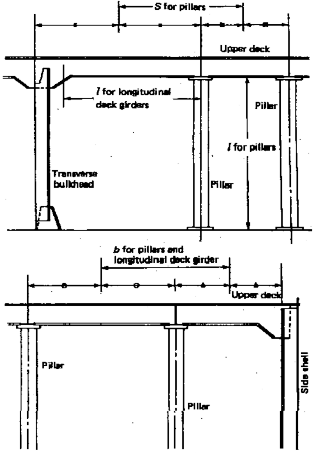

< Previous | Contents | Next >
Section 2 Scantling of Pillars
201. Sectional area of pillars
The sectional area of pillars is not to be less than obtained from the following formula:
LǾĪĪĮE A Ņ Üᾨ
ĪǾKĪ Ň Ü
(cm2)
where:
l = Length of the pillars (m)
ᾟ = Minimum radius of gyration of pillar, obtained from the following formula (cm)
ᾟ Ņ ÜAĀ
where:
Ā = The least moment of inertia of the pillar (cm4)
A = Sectional area of the pillar (cm2)
E = Deck load (kN) supported by pillars as obtained from the following formula:
E Ņ Ċᾎᾜ (kN) where:
Ċ = Distance between the mid-points of two adjacent spans of girders supported by the pillars or the bulkhead stiffeners or bulkhead girders (m) (See Fig. 12.1).
ᾎ = Mean distance between the midpoints of two adjacent spans of beams supported by the pillars or the frames (m) (See Fig. 12.1).
h = Deck load specified in Ch 10, Sec 2 for the deck supported (kN/m2)
![]()

Fig 12.1 The way of measuring Ċ, ᾎ and l for pillars, transverse and longitudinal girders.
202. Thickness
1. The plate thickness of tubular pillars is not to be less than obtained from the following formula.
This requirement may, however, be suitably modified for the pillars provided in accommodation spaces.
ᾼ Ņ LǾLĪĪ ᾘᾬ Ñ ĮǾĴ (mm)
where :
ᾘᾬ = Outside diameter of the tubular pillar (mm)
2. The thickness of web and flange plate of built-up pillars is to be sufficient for the prevention of local buckling.
203. Outside diameters of round pillars
The outside diameter of solid round pillars and tubular pillars is not to be less than 50 mm.
204. Pillars provided
1. Pillars provided in
2. The sectional area
in deep tanks
deep tanks are not to be of tubular pillars.
of pi1lars is not to be less than specified in 201. or obtained from the follow-
![]()
ing formula, whichever is the greater.
A Ņ ÌǾLĶ Ċᾎᾜ (cm2)
where:
Ċ , ᾎ = As specified in 201.
h = 0.7 times the vertical distance from the top of deep tanks to the point of 2 m above the top of overflow pipe (m)